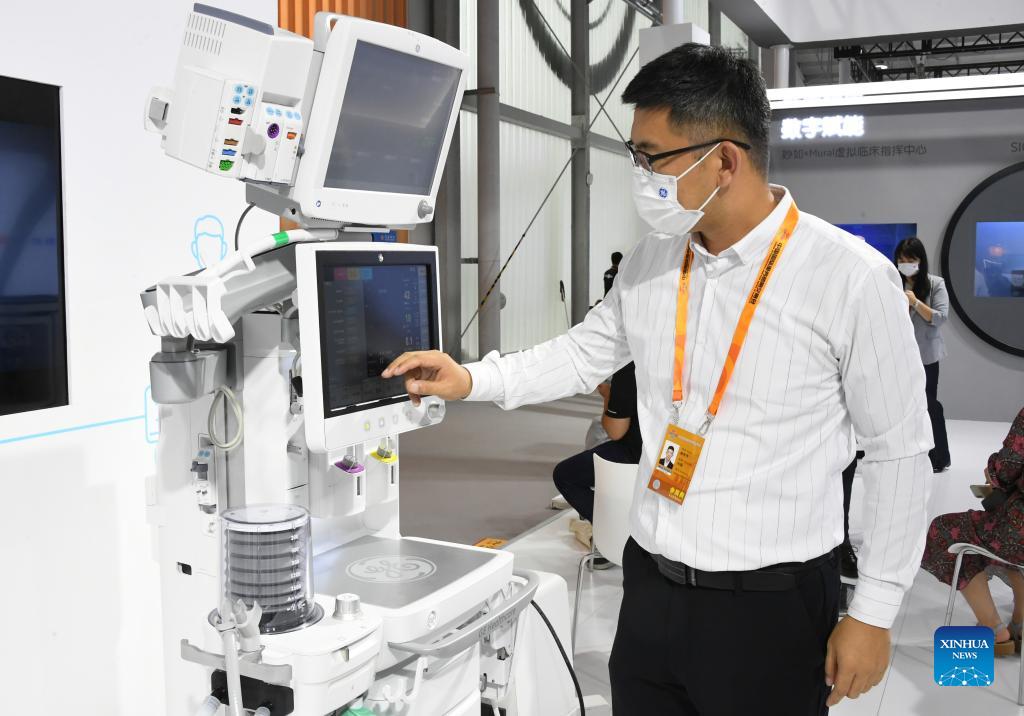CIFTIS injecting vitality into post-pandemic global economy
The 2021 China International Fair for Trade in Services (CIFTIS) kicked off in Beijing on Sept. 2, injecting fresh hope into the COVID-19-battered global economy, as well as providing smart solutions for the digital economy and carbon neutrality.
As the world’s first comprehensive fair for the trade in services and one of the three exhibition platforms for opening up in China, the 2021 CIFTIS has attracted more than 12,000 enterprises, up 52 percent from 2020. Representatives from 153 countries and regions have participated in the event, compared to 148 last year.
“The 2021 CIFTIS is a timely and important event, which highlights many key subjects for the recovery of the global economy in the post-pandemic era. It will help to identify and resolve many of the emerging issues,” Professor Mohan Munasinghe, former vice chair of the UN Intergovernmental Panel on Climate Change that shared the 2007 Nobel Peace prize, and former senior advisor on sustainable development at the World Bank, told People’s Daily Online.
The trade in services covers a wide range of services that can be traded, like those in finance, telecommunication, logistics, human resources, education, healthcare, construction, advertising, computing and accounting. According to statistics, China’s trade in services rose 7.3 percent year-on-year to 2.81 trillion yuan ($434.99 billion) in the first seven months of this year, a major factor that has kept China’s economy humming during the pandemic.
China has promised to be more open in its services sector. After the signing of the Regional Comprehensive Economic Partnership in November 2020, China has decided to open up more than 120 service sectors, 22 more than it agreed to open upon accession to the World Trade Organisation. In July, the country introduced its first negative list for cross-border trade in services at the Hainan free trade port, marking the highest level of opening-up in the cross-border trade realm.
The power of digital trade
 A staff member demonstrates an anesthesia machine in health care services exhibition hall during the 2021 China International Fair for Trade in Services (CIFTIS) in Beijing, capital of China, Sept. 4, 2021. (Xinhua/Ren Chao)
A staff member demonstrates an anesthesia machine in health care services exhibition hall during the 2021 China International Fair for Trade in Services (CIFTIS) in Beijing, capital of China, Sept. 4, 2021. (Xinhua/Ren Chao)
In the digital demonstration zone, a digital RMB Avenue was set up to enable visitors to get a closer look at different usage scenarios for digital currencies. Inside the exhibition hall, one could see intelligent welcoming robots and automatic coffee-making robots busy serving customers, while a robotic dog patrolled the hall, sniffing out any lurking danger with the help of AI and big data.
As digital services have become a new engine for global trade, the theme for this year’s CIFTIS is “Towards Digital Future and Service Driven Development,” with a digital service exhibition zone having been set up for the first time, covering 11,000 square meters.
In an effort to boost trade in digital services, China for the first time included this burgeoning sector into its newly-formulated 14th five-year plan on the development of the service trade. In 2020, China's trade volume in digital services saw a yearly increase of 8.4 percent, accounting for over 40 percent of the total trade in services. The country’s bustling digital economy has spawned thousands of startups, many of which have now become leading tech giants in the international arena.
According to a recent report published by global consultancy firm McKinsey &Co, a large gap in the digital dimension separates a handful of leading countries and the rest of the world. The report ranked 139 countries on the basis of inflows and outflows of goods, services, finance, people and data, with China taking the seventh place globally. The report also noted that advanced economies in general remain more connected than developing countries.
“COVID-19 has accelerated the growth of digital technology and touchless transactions, while greatly enhancing the scale, scope and speed of digital trade – through increases in efficiency and reductions in costs. It is clear that the post-pandemic growth of digital trade will help resuscitate the global economy by accelerating the recovery of damaged global supply chains and creating more livelihoods,” said Munasinghe.
According to Munasinghe, “as a global digital technology leader, China is becoming a super-connector, enhancing East-West and South-North links via the BRI. By helping to better connect sustainable consumers and sustainable producers in the digital marketplace, digital trade can accelerate the growth of sustainable lifestyles and behaviors, thereby making the world a better place for us all, and for future generations.”
Trade in services connecting the world
According to statistics, in addition to digital services, a variety of other service categories, including personal, cultural and entertainment services as well as transportation and logistics services, are also major areas for cooperation between China and other nations.
“This is our third time participating in CIFTIS. We come to introduce service industries that are important for the further development of our bilateral economic cooperation, such as investments, logistics and tourism. In addition to that we are showcasing traditional food and beverage products from Azerbaijan. We are going to set up a new Alat Free Economic Zone in Azerbaijan next year, and CIFTIS would be a good platform to seek for potential cooperation,” said Teymur Nadiroghlu, trade representative from the Embassy of the Republic of Azerbaijan to China.
Conor O’sullivan, China manager at Bord Bia of the Irish Food Board, noted that thanks to the booming trade in services between China and Ireland, whisky exports to China during the first half of 2021 have grown four times from what they were in 2020.
“The CIFTIS has provided us a platform to showcase trade in services from different nations, as well as demonstrating our unique culture. It will help different nations to connect with each other in the post-pandemic era,” said Zahid Ahma, a sales manager from Nepal.